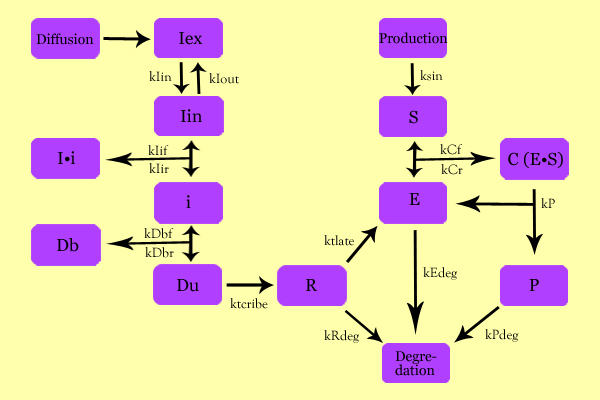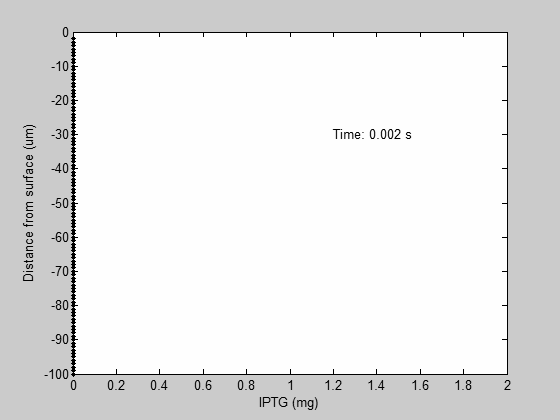Team:Northwestern/Project/Modeling
From 2010.igem.org
(Difference between revisions)
(→Objective) |
|||
| Line 154: | Line 154: | ||
=='''Objective'''== | =='''Objective'''== | ||
| - | The purpose of modeling was to characterize the | + | The main purpose of modeling was to characterize the topography of the kinetics behind foreign protein/product production in recombinant E.Coli biofilm with a diffusing inducer, and the effect on the various species involved by primarily the following factors: |
| - | + | # Time-derivative Spatial-Gradient Inducer Concentration | |
| + | # Repressor Concentration | ||
| + | # Ribosome Binding Site (Rate of Transcription) | ||
| + | |||
| + | In terms of our iGEM project, this model was to explore the effect of IPTG concentration and diffusion, lacI concentration (determined by the combination part of constitutive promoter, ribosome binding site, lacI gene, double terminator, lac promoter/operon), and the ribosome binding site on the concentrations of all species involved - described in the following sections - and especially on Chitin Synthase and Chitin concentration and the corresponding rates. | ||
=='''Modeling'''== | =='''Modeling'''== | ||
| - | + | ==='''Overall Model'''=== | |
| - | Using | + | Using enzyme kinetics equations, we elected to mathematically simulate the following model: |
[[Image:SuperModeling.jpg|600px|center]] | [[Image:SuperModeling.jpg|600px|center]] | ||
| Line 190: | Line 194: | ||
P: Protein Product (Chitin or (NAG)n+1) | P: Protein Product (Chitin or (NAG)n+1) | ||
| + | ==='''IPTG Diffusion'''=== | ||
| + | |||
| + | First, Fick's Law of Diffusion was modeled through MATLAB. The diffusion constant used was 220um^2/s.[4] | ||
| + | |||
| + | [[Image:loopydoops.gif|300px]] | ||
| + | |||
| + | The x-axis is IPTG mass in milligrams, while the y-axis is distance from the surface. | ||
| + | |||
| + | The top layer | ||
| + | |||
| + | |||
| + | ==='''Semi-Empirical Determination'''=== | ||
| + | |||
| + | |||
| + | ==='''Fitted Model'''=== | ||
Matlab was used to generate a theoretical model where IPTG would diffuse down the biofilm as according to Fick's Law of Diffusion and initiate the process. The extracellular substrate concentration was assumed to be much greater than the uptake/use, and so would diffuse in at a constant rate. | Matlab was used to generate a theoretical model where IPTG would diffuse down the biofilm as according to Fick's Law of Diffusion and initiate the process. The extracellular substrate concentration was assumed to be much greater than the uptake/use, and so would diffuse in at a constant rate. | ||
| Line 204: | Line 223: | ||
=='''References'''== | =='''References'''== | ||
| - | '''A novel structured kinetic modeling approach for the analysis of plasmid instability in recombinant bacterial cultures''' | + | '''1. A novel structured kinetic modeling approach for the analysis of plasmid instability in recombinant bacterial cultures''' |
William E. Bentley, Dhinakar S. Kompala | William E. Bentley, Dhinakar S. Kompala | ||
| Line 212: | Line 231: | ||
| - | '''Mathematical modeling of induced foreign protein production by recombinant bacteria''' | + | '''2. Mathematical modeling of induced foreign protein production by recombinant bacteria''' |
Jongdae Lee, W. Fred Ramirez | Jongdae Lee, W. Fred Ramirez | ||
| Line 220: | Line 239: | ||
| - | '''Pool Levels of UDP N-Acetylglucosamine and UDP NAcetylglucosamine-Enolpyruvate in Escherichia coli and Correlation with Peptidoglycan Synthesis''' | + | '''3. Pool Levels of UDP N-Acetylglucosamine and UDP NAcetylglucosamine-Enolpyruvate in Escherichia coli and Correlation with Peptidoglycan Synthesis''' |
DOMINIQUE MENGIN-LECREULX, BERNARD FLOURET, AND JEAN VAN HEIJENOORT* | DOMINIQUE MENGIN-LECREULX, BERNARD FLOURET, AND JEAN VAN HEIJENOORT* | ||
| Line 228: | Line 247: | ||
| - | '''Diffusion in Biofilms''' | + | '''4. Diffusion in Biofilms''' |
Philip S. Stewart | Philip S. Stewart | ||
| Line 236: | Line 255: | ||
| - | '''Regulation of the Synthesis of the Lactose Repressor''' | + | '''5. Regulation of the Synthesis of the Lactose Repressor''' |
PATRICIA L. EDELMANN' AND GORDON EDLIN | PATRICIA L. EDELMANN' AND GORDON EDLIN | ||
Revision as of 22:29, 25 October 2010
| Home | Brainstorm | Team | Acknowledgements | Project | Human Practices | Parts | Notebook | Calendar | Protocol | Safety | Links | References | Media | Contact |
|---|
 "
"







